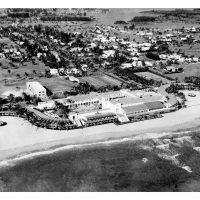The Surf Club Then, 20th Century

In 2012, I had the opportunity to interview Charles Gilatt, the oldest living member of The Surf Club.
Charles Gilatt: The wind used to whistle through The Surf Club because originally they didn’t have a roof over it. There was a main walkway, but it was open-sided toward where lunch was served. After World War II, Winston Churchill used to sit in the lunch area with a bottle of scotch. I was a young man, but we were told, ‘Don’t talk to Mr. Churchill. He doesn’t want to be talked to.’
The manager of the club was Alfred Barton. He was a socialite, or a ‘would-be socialite.’ He didn’t marry, except once for six months, but lived mostly with his mother. He was tall and distinguished. He invited people to become members of the club, most of whom were flattered and joined, much to my brother’s distaste. Barton managed The Surf Club from the 1930s to the ’60s.
The Surf Club was famous for its galas — every other Saturday from early December until Easter. They were almost always black tie. Under Alfred Barton’s direction, the galas often involved stage productions. One could experience the South Seas islands one weekend and London the next. He staged a marvelous duplication of the coronation of Queen Elizabeth II. Barton included Beefeaters in proper attire, stationed in the entryway to The Surf Club.
We eventually burned all the sets because they were a fire hazard.
Every Sunday there was a big lunch following church services. Everyone was well-dressed.
The Surf Club was used as a recuperation hospital for officers during World War II.
There were no female employees at The Surf Club before the War. Alfred Barton was a one-gender man.
The best decade for The Surf Club was probably the first decade. The only other club that could compare to the Surf Club was the Bath Club, which opened in the mid-1920s. They had millionaire members, but they didn’t have enough of them. Eventually all of the Bath Club members joined The Surf Club.
The Club was not a New York Club. It was a Chicago-Ohio Midwest Club. Many of the members were connected to the auto industry.
The Club had a membership limit of 400 people, but it never reached 400. The Club began a slow decline when jet planes replaced prop planes and other more exotic locations became practical for auto industry conferences. The dwindling membership is the reason that the elevator has been out of service for 20 years. In 2012, there were approximately 110 proprietor members before The Club was sold to Fort Partners.
Excerpts from The Surf Club by Pamela Fiori and Tom Austin. Assouline Publishing:
When the club opened on New Year’s Eve 1930, America was in the early stages of the Great Depression, and not exactly in a partying frame of mind. Prohibition was at its tail end, but obtaining liquor was still done sub-rosa. However, liquor-laden boats from Bimini and Cuba would pull up on the beach in front of the Surf Club and unload cases of the forbidden elixir to club members who imbibed in the privacy of their cabanas, many of which were as lavishly decorated as their own homes – some even more so.
The idea for the club was hatched on a yacht owned by Harvey Firestone, the tire tycoon. He and his cronies, including Carl Fisher, who developed Miami Beach in 1913, were hankering for a place to hide. The initial membership was predictably for men only, as was commonplace at the time. An early roster was composed of prominent American businessmen, who wielded a great deal of power, but were lacking in glamour. However, the glitterati and the literati soon arrived, if not always as member, then as guests.
Among the notables who enjoyed the Surf Club were Noel Coward, Tennessee Williams, DuBose Hayward, Gary Cooper, Douglas Fairbanks, Jr, Frank Sinatra, Elizabeth Taylor, Dean Martin, Winston Churchill, General Douglas MacArthur, and the Duke and Duchess of Windsor.





